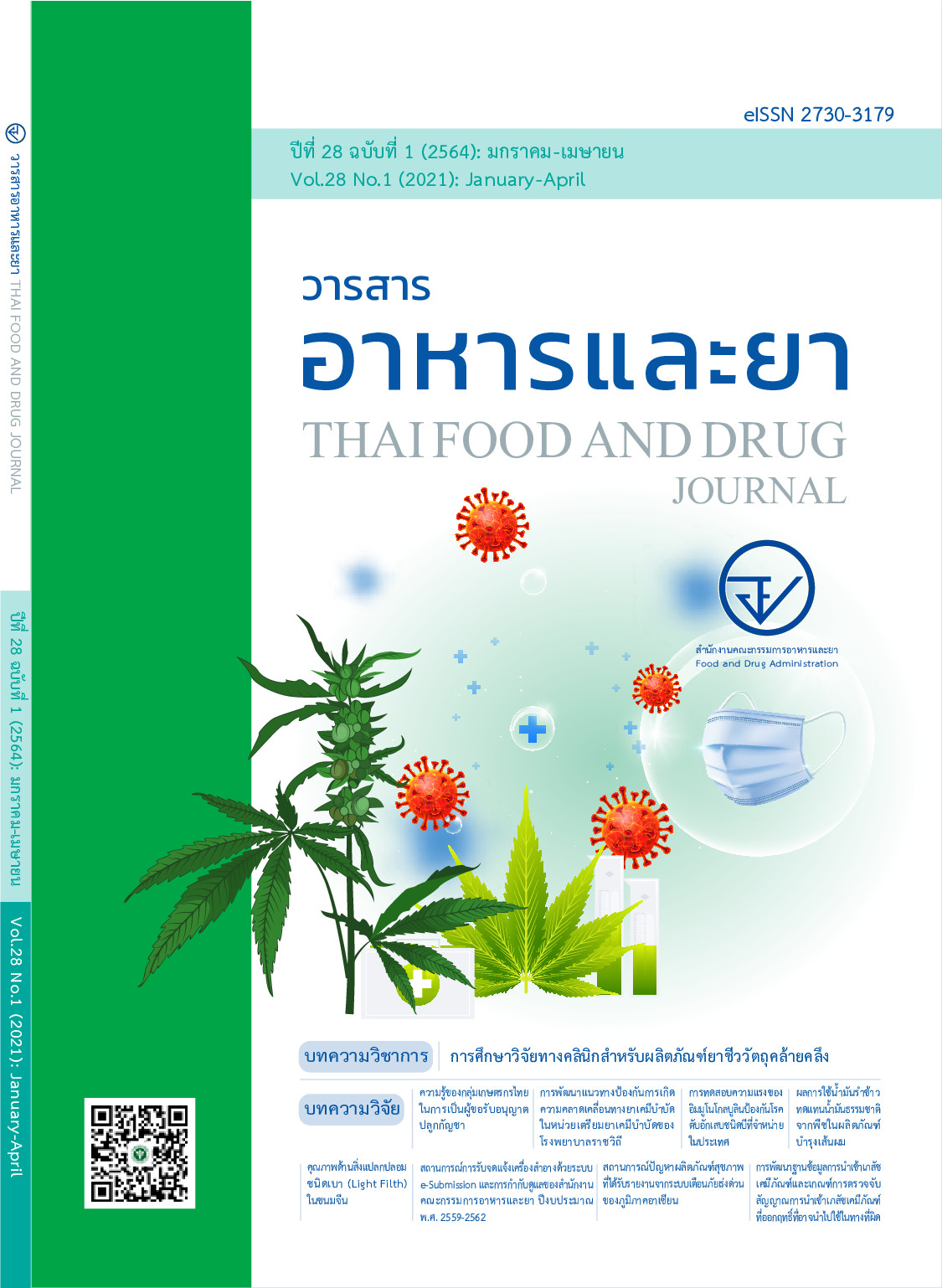Effect of Replacing Natural Plant-based Oils with Rice Bran Oil for Hair Care Products
Main Article Content
Abstract
Background: Each of natural plant-based oil have specific fatty acid composition that depending on their plant sources. So, they effect on hair physical properties. The saturated and monounsaturated fatty acids can penetrate into hair that they enhance the structure of hair for strength and flexible and polyunsaturated. The fatty acids can improve hair coat to make shiny, soft, and manageable.
Objectives: To study results of physical, chemical, stability, and preference of hair oil products and hair conditioner products from rice bran oil that replaced natural oil.
Methods: This research was an experiment in laboratory by created hair oil formula that contained rice bran oil and argan oil, also hair conditioner formula that contained rice bran oil and olive oil blends with sweet almond oil. Then, we compared physical and chemical properties including color, odor, product texture, pH, and viscosity. Besides, it tested a preference of the hair oil product at 20 people and the hair conditioner products at 27 people by using 9-point hedonic scale.
Results: There was no different of all parameters in physical, chemical characteristics, and paired preference tests between rice bran oil formula with argan oil and olive oil blends with sweet almond oil for hair oil products and for hair conditioner products, respectively. Stability test of rice bran oil formula for hair oil and hair conditioner products was adequately to use as the product ingredient.
Conclusions: The rice bran oil can be used for an emollient agent in hair oil and hair conditioner products by replacing natural plant-based oils formula in hair oil 100% and hair conditioner 75%. The results of this study yielded to reduce imported raw materials cost.
Article Details
References
2. Science-y Hair Blog. Oils – which ones soak in vs. coat the hair? [Internet]. 2016 [cited 2019 May 7]. Available From: http://science-yhairblog.blogspot.com/2013/06/oils-which-ones-soak-in-vs-coat-hair.html
3. Dias MFRG. Hair cosmetics: an overview. Int J Trichology 2015;7(1):2-15. doi: 10.4103/0974-7783.153450.
4. Rele AS, Mohile RB. Effect of mineral oil, sunflower oil, and coconut oil on prevention of hair damage. J Cosmetic Sci 2003;54(2):175–92. PMID: 12715094.
5. Fregonesi A, et al. Brazilian oils and butters: The effect of different fatty acid chain composition on human hair physiochemical properties. J Cosmetic Sci 2009;60(2):273-80. PMID: 19450426.
6. In-cosmetics asia. Top trends and opportunities in haircare: global data [Internet]. 2018 [cited 2019 May 7]. Available From: https://asia.in-cosmetics.com/RXUK/RXUK_In CosmeticsAsia/2018/Marketing_Trends_2018/Day_1_12.00_Sumit_Chopra_GlobalData_OK.pdf?v=636764113969516420
7. Zielinska A, Nowak I. Fatty acids in vegetable oils and their importance in cosmetic industry. Chemik 2014;68:103-10. [cited 2019 Jul 14]. Available from: https://www.researchgate.net/publication/286712435_Fatty_acids_in_vegetable_oils_and_their_importance_in_cosmetic_industry
8. Science-y Hair Blog. Product pH List [Internet]. 2018 [cited 2019 May 7]. Available From: http://science-yhairblog.blogspot.com/2018/12/product-ph-list.html
9. กระทรวงอุตสาหกรรม. ประกาศกระทรวงอุตสาหกรรม ฉบับที่ 4965 (พ.ศ. 2560) เรื่อง กำหนดมาตรฐานผลิตภัณฑ์อุตสาหกรรม ผลิตภัณฑ์นวดผมชนิดล้างออก. ราชกิจจานุเบกษา เล่ม 164, ตอนพิเศษ 106 ง (ลงวันที่ 14 กุมภาพันธ์ 2560).
10. Making Cosmetics. Stability testing of cosmetics [Internet]. Redmond WA: Making Cosmetics. [cited 2019 Oct 7]. Available From: https://www.makingcosmetics.com/Stability-Testing-of-Cosmetics_ep_59.html
11. CTFA and Colipa. Guidelines on stability testing of cosmetic products [Internet]. Cosmetics Europe; 2004 [cited 2019 Jul 14]. Available from: https://www.cosmeticseurope.eu/files/5914/6407/8121/Guidelines_on_Stability_Testing_of_Cosmetics_CE-CTFA_-_2004.pdf

